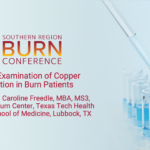Abstract | March 2, 2021
Retrospective Examination of Copper Supplementation in Burn Patients
Learning Objectives
- Evaluate the prevalence of copper deficiency in burn patients;
- Assess the relationship of copper levels and percent total body surface area of the burn;
- Understand the practice of copper supplementation at the ABA burn center population level.
Introduction: Copper deficiency can have a significant impact in the course of recovery for a burn patient. However, it is rarely assessed and not routinely available at most clinical chemistry lab. This trace element deficiency often presents as poor wound healing, impaired blood vessel and connective tissue formation, weakened immunity, and elevated reactive oxygen species (ROS), which can exacerbate illness severity. Therefore, adequate levels of copper are paramount to successful recovery of burn injury patients. Many studies have attempted to determine a formula to correct copper deficiency in burn patients. Opposing results have been found using insufficient patient populations, inaccurate measurement methods, and lack of knowledge on factors that may interfere with copper levels. A lack of congruent evidence on copper deficiency in burn patients necessitates future research to determine whether current measurement and supplementation methods are adequate. We believe that early detection and treatment of copper deficiency can help wound healing and improve burn patient care. The primary focus of this study was to assess copper levels in patients after a severe burn injury and the impact on wound healing. Our secondary objective included an anonymous survey sent to ABA verified burn centers to assess prevalence of copper supplementation and establish a community wide viewpoint on copper deficiency.
Method/Design: We conducted a retrospective clinical study that included patients aged 1-90 years that were admitted to the Timothy J Harner Burn Center from August 1, 2017 to May 2019 for a burn injury or necrotizing soft-tissue infection in which copper levels were evaluated. Using the electronic health records we tracked the incidence of copper deficiency in burn patients as well as TBSA, zinc supplementation, mortality, length of stay, infection episodes, blood transfusions, and wound healing rates as compared to burn patients with normal copper levels. Additionally, we sent an IRB approved anonymous survey to ABA verified regional burn centers that remained open for six weeks. The survey consisted of 10 questions to collect data on frequency of checking copper levels, level of importance placed on copper supplementation, and method used to supplement copper.
Result/Findings: A total of 262 patients were admitted for a burn injury over the two-year period and 59 patients had a copper valued drawn. The average copper value across all patients throughout their hospital stay was 105.8 mcg/dL (s.e. = 4.2) with five total patients experiencing an average copper value below the normal threshold (<63.7 mcg/dL). There was a significant inverse relationship between TBSA and serum copper levels (r = -0.49, t = -3.87, p= 0.0003) but no significant relationships between copper serum copper and zinc supplementation (r=0.01, t = 0.06, p = 0.95). Our survey had a total of 51 total responses out of 310 total surveys sent. A total of 65% of burn centers believed that copper values were important in the care of burn wound and 53% of burn centers checked copper levels in burn patients. Copper gluconate was the most common used supplementation method (50%) and other trace elements often recorded included selenium, zinc, and iron.
Conclusion/Implications: Our study found that only minimal patients had a copper level that was below the threshold considered normal. However, this value was average across their hospitalization and might bias an early copper deficiency in burn patients. There was an inverse relationship with copper and total burn area showing that the larger a burn, the more deficient the patient was in copper. Overall, most burn centers thought that copper values were important in burn care and over half routinely checked copper levels in severe burns. Additionally, most burn centers check other trace elements as part of a complete analysis for severely burned patients. Despite the lack of copper deficiency found at our burn center, overall, the consensus is that copper levels are critical to proper management of severely burned patients. These results suggest that further research is needed to monitor copper levels and wound healing in the severely burned patient.
References and Resources
- Shankar, P., Ph.D, R.D., L.D., Boylan, M., Ph.D., R.D., L.D., & Sriram, K., F.R.C.S.(C)., F.A.C.S. c. (2009). Micronutrient deficiencies after bariatric surgery. Nutrition in Clinical Practice,26, 1031-1037. doi:10.1016/j.nut.2009.12.003
- Berger, M. M., Binnert, C., Chiolero, R. L., Taylor, W., Raffoul, W., Cayeux, M., Tappy, L. (2007). Trace element supplementation after major burns increases burned skin trace element concentrations and modulates local protein metabolism but not whole-body substrate metabolism. The American Journal of Clinical Nutrition,85(5), 1301-1306. doi:10.1093/ajcn/85.5.1301

